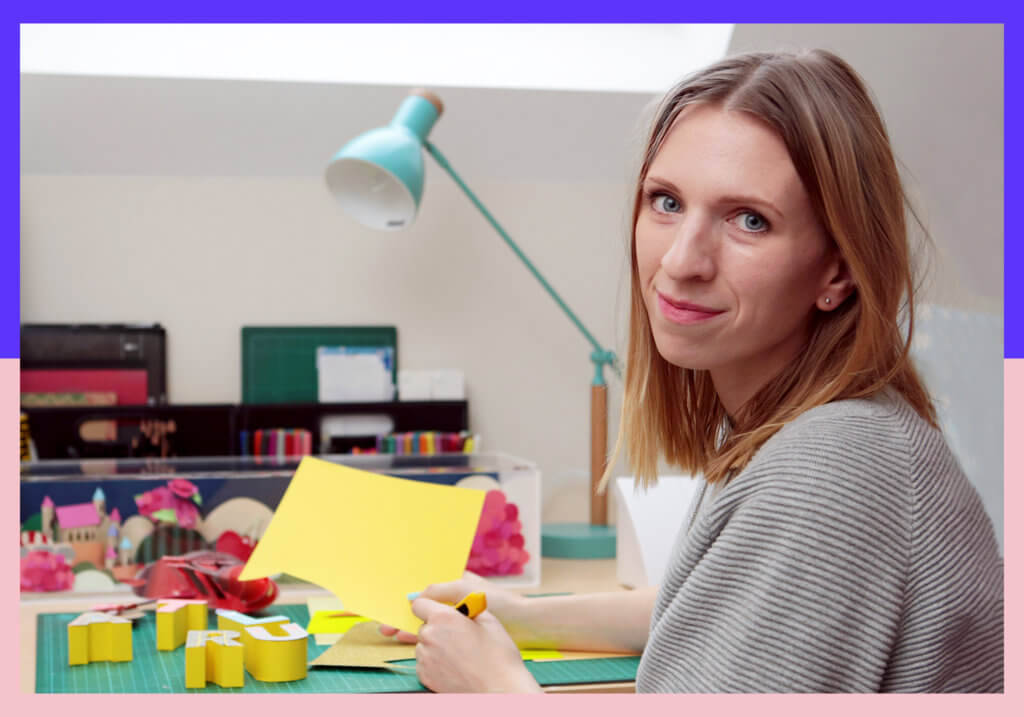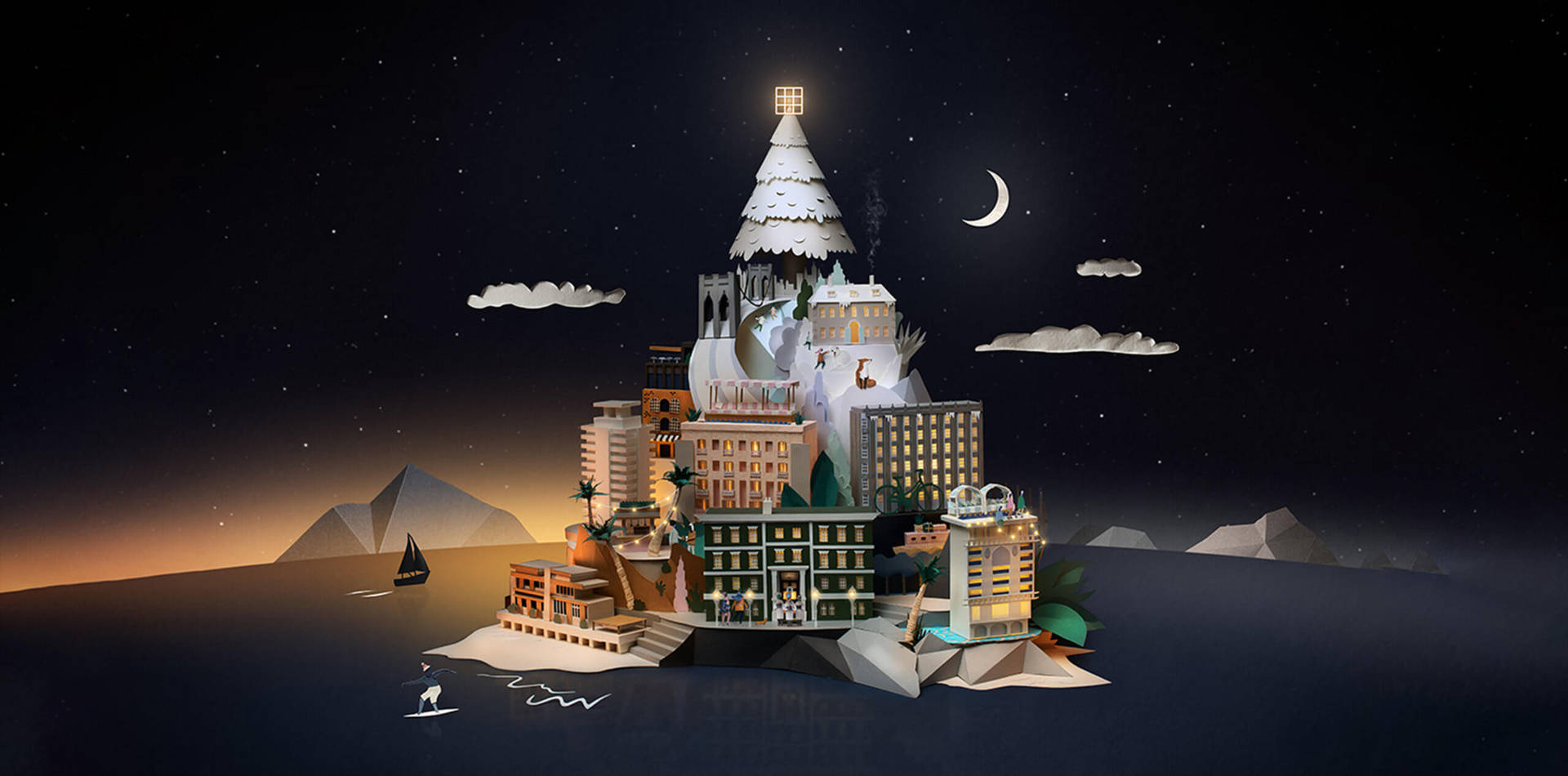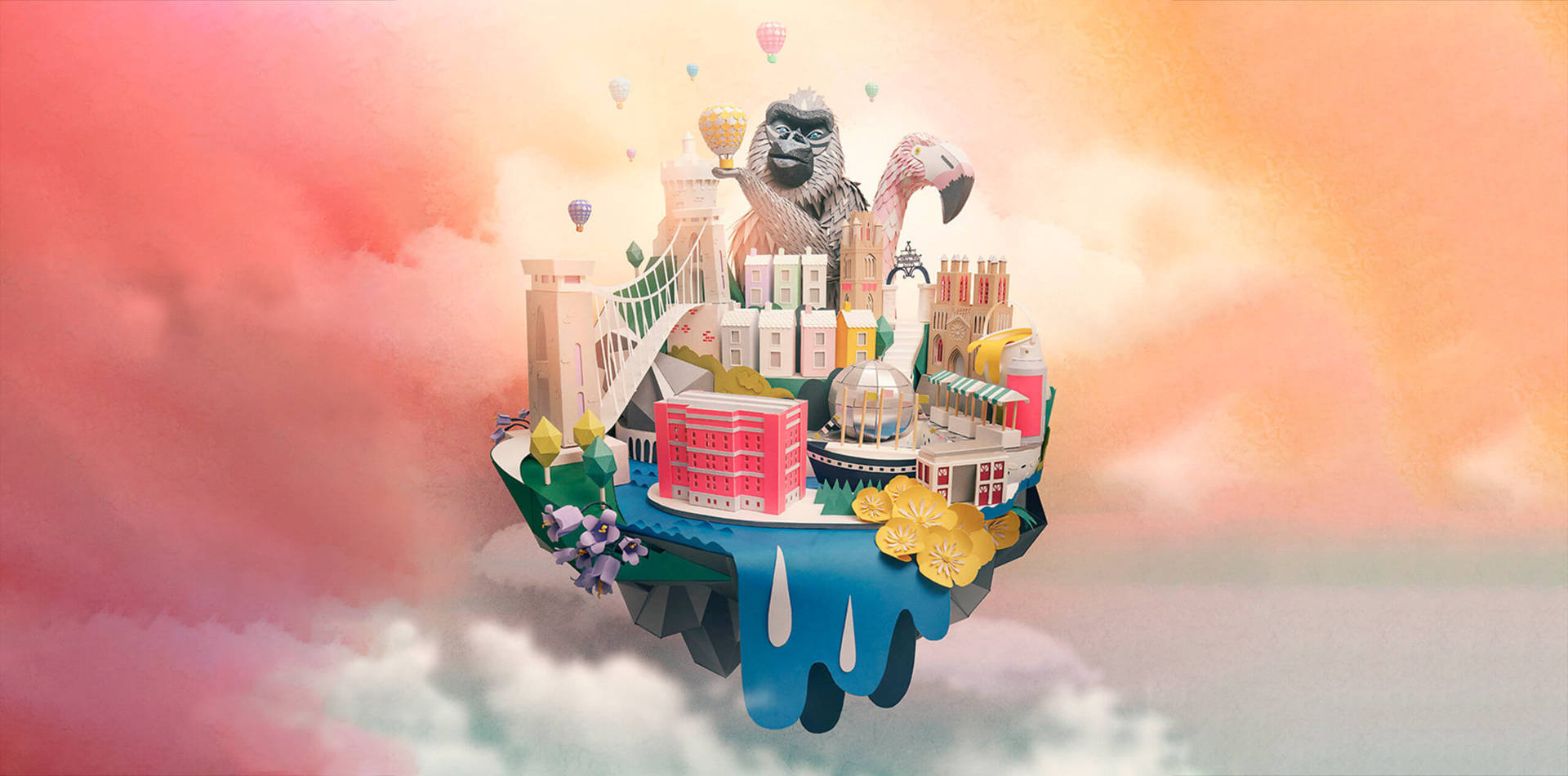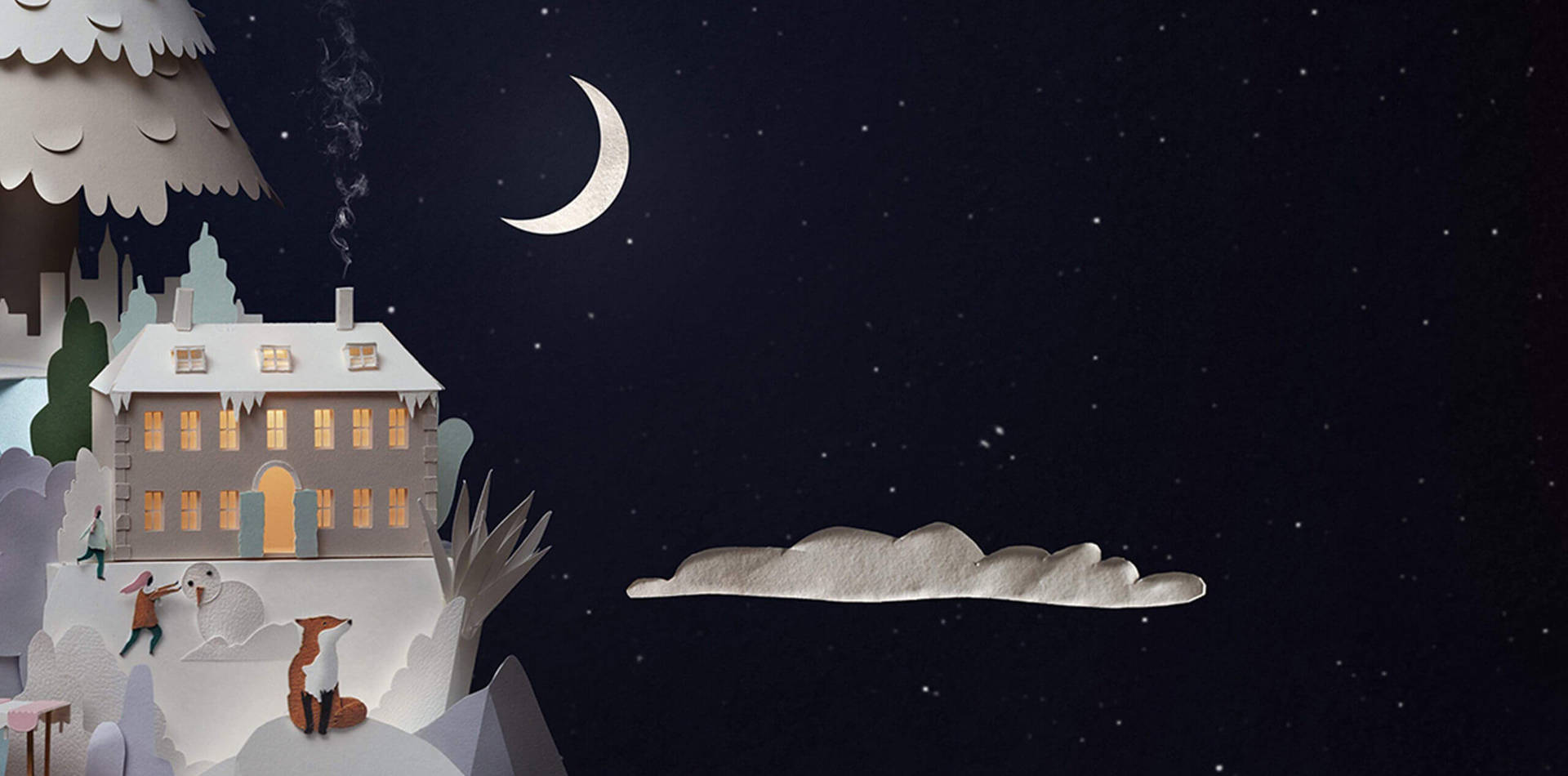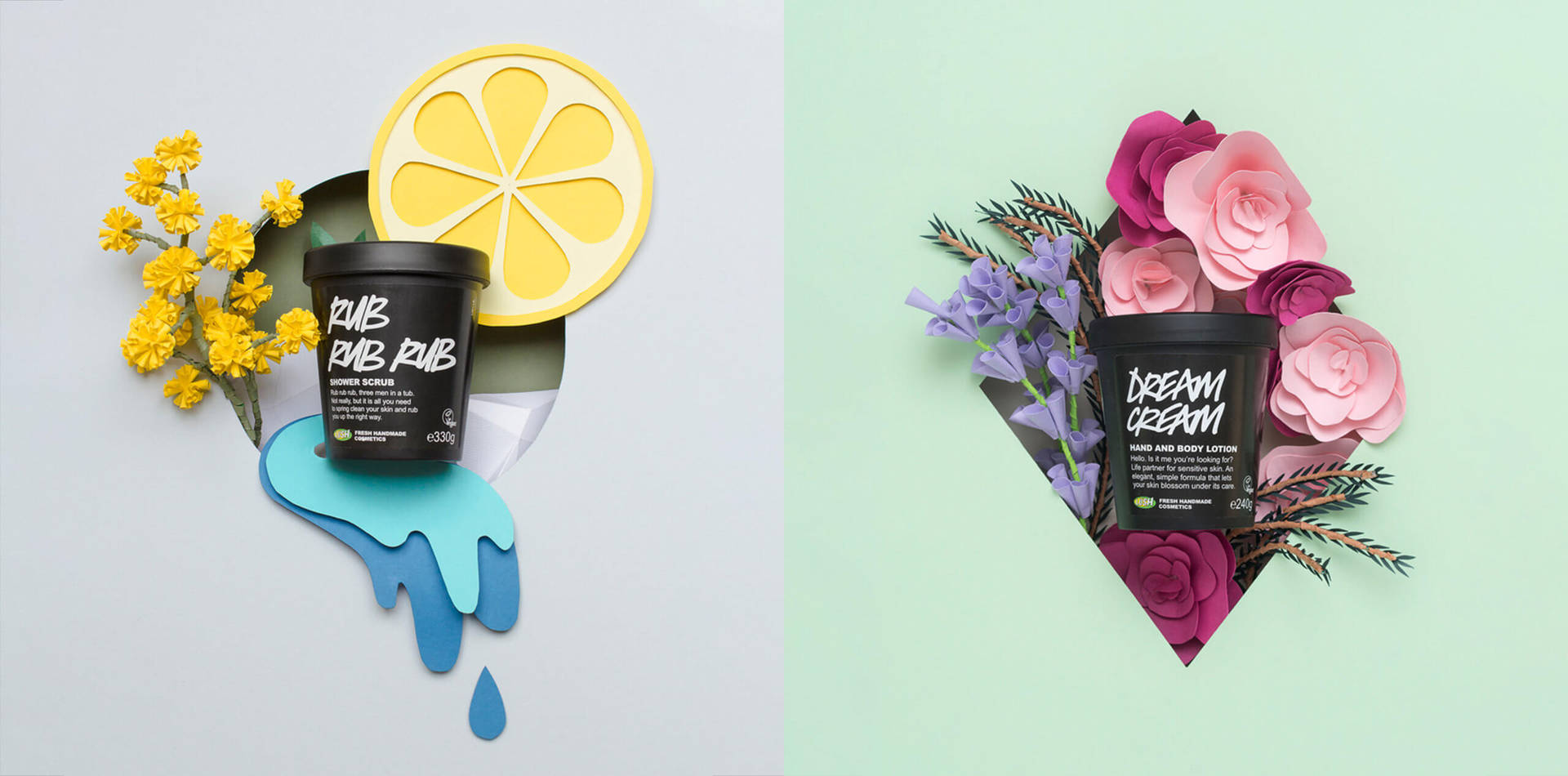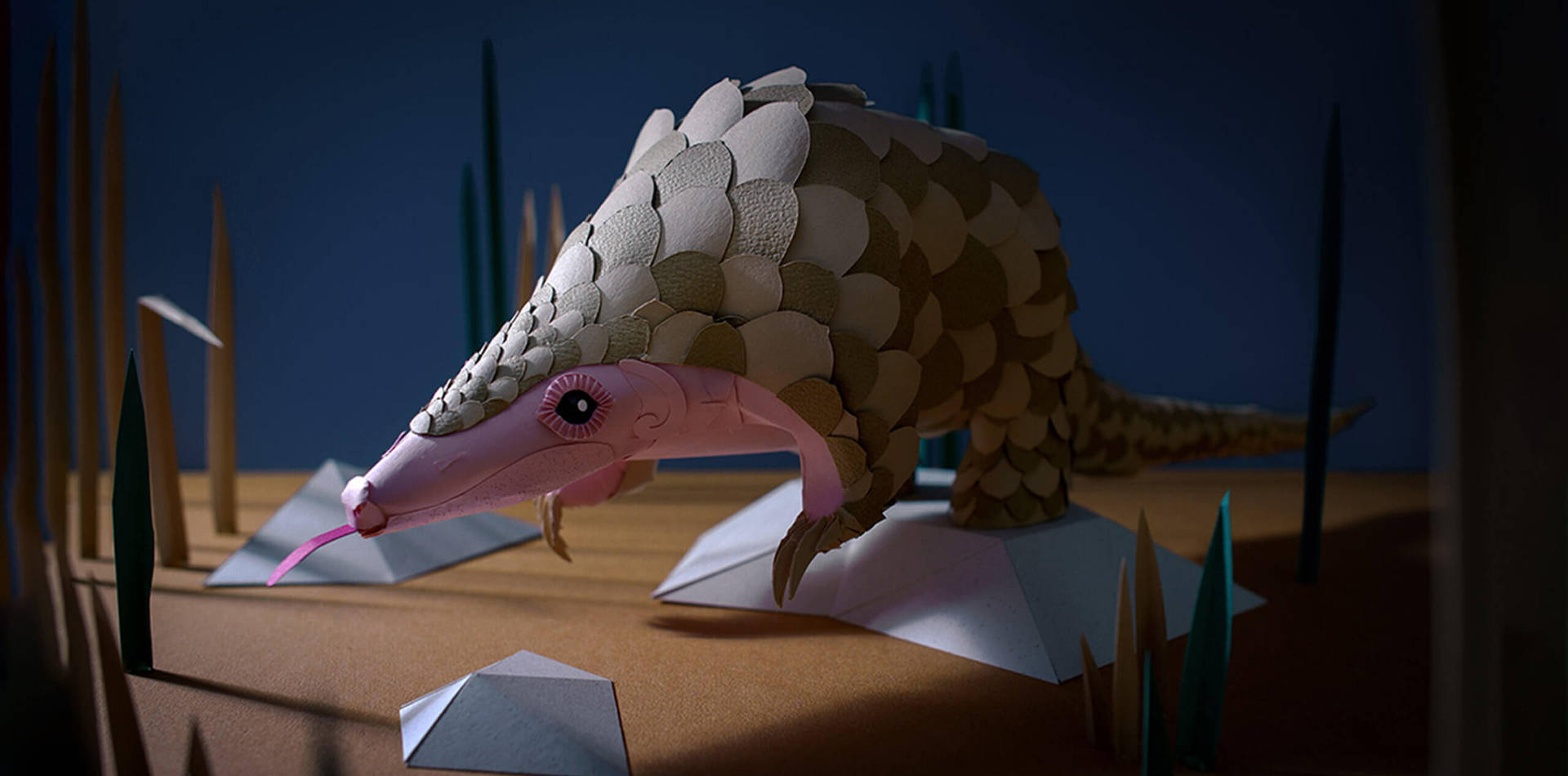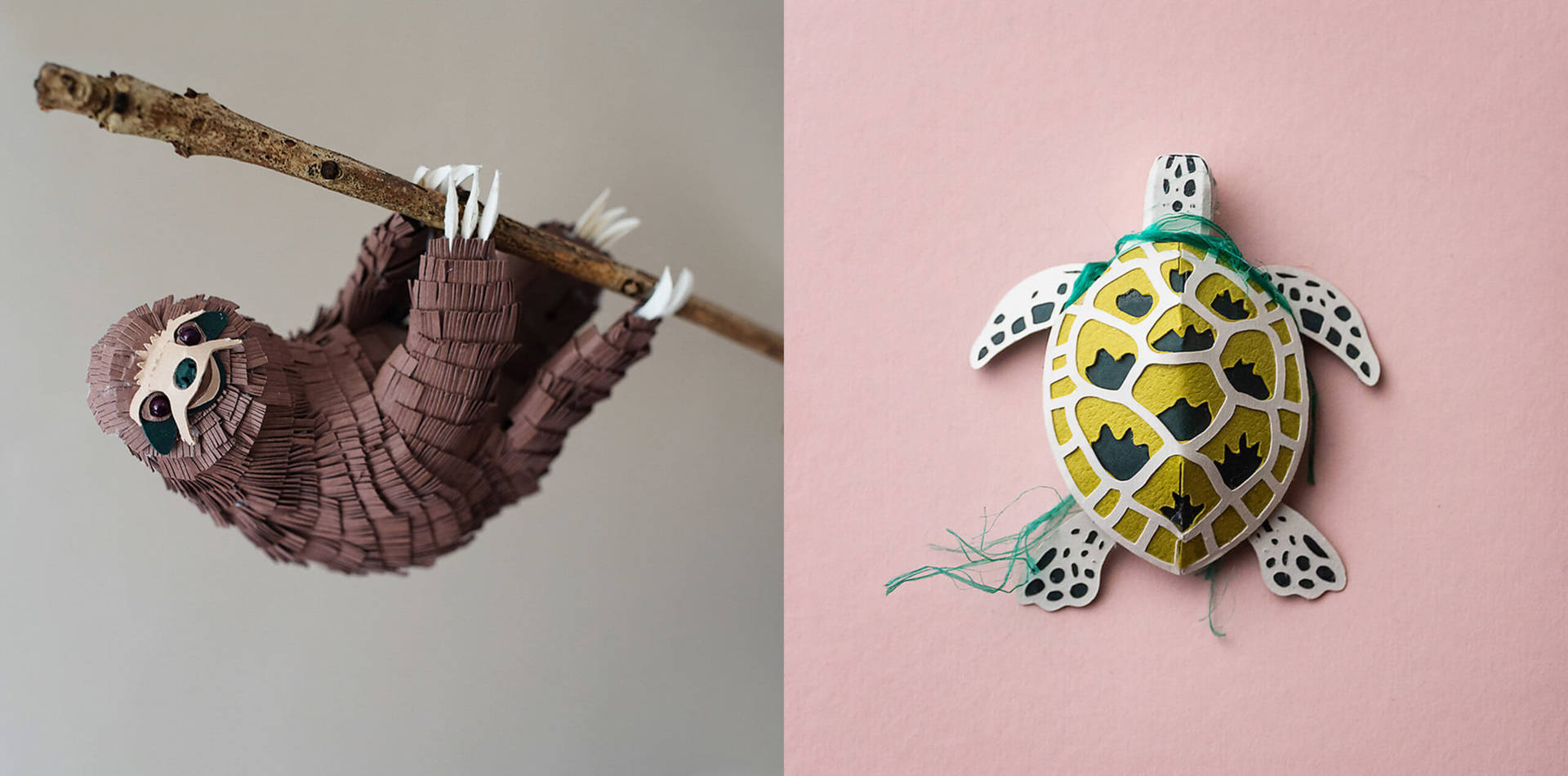Sam Pierpoint is a Bristol (UK) based image maker and art director, who expertly designs and beautifully handcrafts paper sets and sculptures. Projects range from advertising and awareness campaigns to editorial and set design, and her creations have featured in many commercial and artistic projects, attracting such clients as Lush, Soho House, Vegan Society, and the WWF – to name just a few!
Sam’s work is heavily influenced by a passion for nature and incorporates architectural references with strong geometric shapes. She creates highly detailed and playful pieces that often have a magical quality. All of her 3D creations are carefully crafted using high quality papers before being photographed and edited digitally to make the final piece.
During her last year of university Sam began experimenting with collage and paper craft processes. The jump from 2D to 3D evolved over time. Through studying the work of pop-up artists she developed a unique style and approach in technical exercises and project briefs. After graduating, she spent a number of years working in ‘non-design’ part time jobs, until freelance commissions started to come in more regularly and she was able to set up a studio as a full-time illustrator and paper artist. She remembers that this as a tough time but believes that it pushed her to find her own stylistic voice and understand the importance of resilience and perseverance.
Sam’s love for the natural world has always been a big influence on her personal projects and in recent years has become an important part of her practice. She loves creating illustrations with a purpose and believes strongly in putting her creative skills to good use, raising awareness around important topics and causes that affect us all. As she told us, “I’ve definitely become more mindful about my purpose as an illustrator. The climate crisis is on my mind daily. I experience a mixture of eco anxiety mixed with a surge in energy to do something about it… I’ve found solace in learning about behavioural change. The issues that I’m most struck by include over consumption, plastics, food, our connection to nature and social, racial and economic inequalities.” This ethos has prompted her to create work for ‘Extinction Rebellion’s Rebel Art Auction’ and WWF’s ‘Earth Hour’. Most recently, she’s been involved in projects for PEFC on their ‘Fashions Change, Forests Stay’ campaign to connect the fashion industry to sustainably managed forests and with the Marine Conservation Society on their ‘Stop Ocean Threads’ campaign.
Sam believes that having a strong purpose is key to a creative career, as well understanding what you’re most passionate about and what gives you joy. Together these things will lead to unique, genuine work that truly represents you!
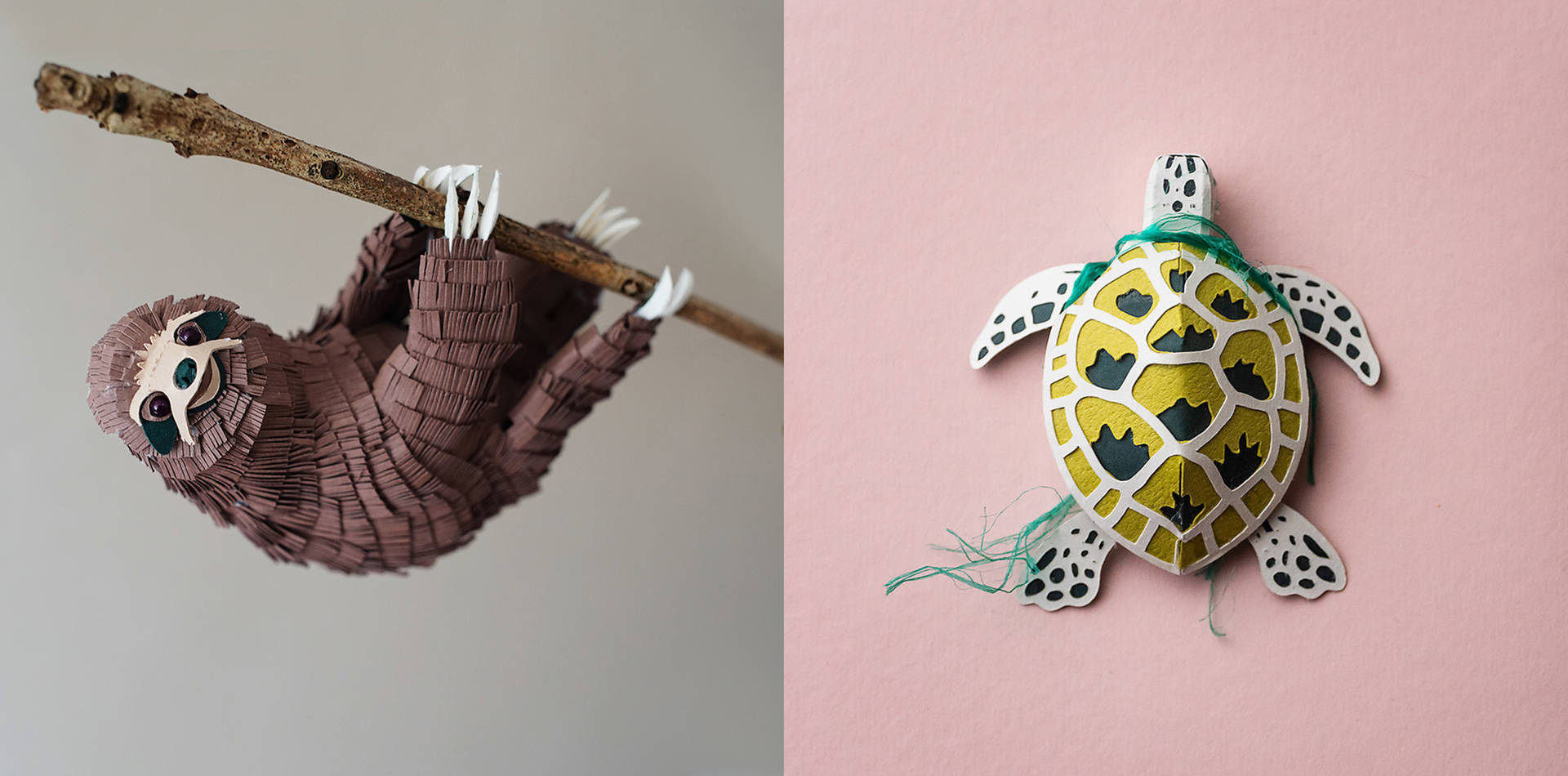
We caught up with Sam to discuss how she developed her project process, her approach to client briefs and why raising awareness for environmental causes has become integral to her creative work.
How did you first become interested in working as a paper artist?
In my last year at Nottingham Trent University (2008), I bought lots of interesting looking papers from my uni shop thinking I could somehow use it within my illustration work. It started as collage and then layers raised off the page. A year later after lots of play and experimenting with paper, I started to push it more in the direction of 3D sculpture and felt like I was beginning to find my own process for making the work.
I remember a few books really helped me at the time: ‘Tangible’ by Matthias Hubner and ‘Tactile’ by Sonja Commentz, and for anything pop-up: ‘The Elements of Pop-up’ by James Diaz and David A. Carter and ‘Pop-up Design and Paper Mechanics’ by Duncan Birmingham.
It was really drummed into us at university that we should find our own unique illustrative style and I remember really enjoying the process of searching for it. It was like inventing a new recipe. You try lots of things — most of which fail and look awful — but then every once in a while you stumble across something that works and then you do more of that.
Describe your career path of how you got to where you are now.
It took a long time! I’ve never been good at job interviews, so as much as I would have wanted to start off working in a design agency to learn more about the industry it just didn’t happen. Although that wasn’t ideal, I guess in a way the experience worked in my favour because I was able to spend time working on my own projects and having the space to think about which direction to push my work in.
Some of the part-time work, especially the work in pubs and offices, I found very mind numbing and that gave me the sense of urgency I needed to make my career work. After uni, I spent around 6 years working in random part time jobs before I could work full time as an illustrator. Patience and perseverance were definitely key during that time.
At the start, the type of illustration work I took on was mostly record labels. Someone told me that it was easier to find work in that area and the briefs were quite relaxed. Although there wasn’t much money in working with small record labels, I found it was a good place to start. I love electronic music, so I really enjoyed the level of freedom and play that came along with working with techno and deep house record labels.
Whilst I was still working part time, I found some time to create a couple of self-initiated larger paper city sculptures. It was at that point when I started collaborating with my partner, Mike. He began to photograph and retouch the sculpture images, which really helped to give them a nicely finished aesthetic and attracted the attention of some advertising and design agencies. This led to my first commercial project. Collaborating with directors from agencies and producing sculptures which Mike would then photograph and re-touch worked well. One advertising project led to another and, with the income I made, I was able to move to working as a full-time illustrator.
More recently, I’ve definitely been more mindful about my purpose as an illustrator. The climate crisis is on my mind daily It produces a mixture of anxiety and surges in energy to do something about it; although I’m sitting in despair not knowing what I should do half of the time! I’ve found solace in learning about the possibilities of behavioral change. Issues that I’m most struck by include over consumption, plastics, food, our connection to nature and social, racial and economic inequalities. Connecting with inspirational individuals, charities and groups has helped massively. It’s this which has prompted me to work on some self-initiated projects such as the paper turtle for Extinction Rebellion’s Rebel Art Auction and an animation for WWF’s Earth Hour.
More recently, I’ve been over the moon to be working with PEFC on their ‘Fashions change, Forests stay’ campaign to connect the fashion industry to sustainably managed forests and the amazing materials that come from them. As well as working with Marine Conservation Society on their Stop Ocean Threads campaign, asking the public to sign a petition, which will push for legislation to stop microfibre pollution at source, by requiring all new washing machines to have microfibre filters fitted by 2024.
If you have a spare few minutes and would like to help MCS #StopOceanThreads, you can sign the petition here: www.mcsuk.org/campaigns/microfibrecampaign-home
How have you grown and developed throughout your career?
I owe a lot to the Association of Illustrators. I entered the world of illustration with no business knowledge and they have really helped me to become confident about licensing and contracts etc. I think that has played a big part in helping me to grow. Also, I’m very lucky to have a partner who is a professional photographer and videographer. He’s able to capture my work and give it a high-end finish which is an integral part of the process. Being able to take on that side of things in-house along with animation and retouching has been extremely helpful.
I’m constantly trying to make myself more aware of challenges we face as a species and the threats towards the planet. As an artist I can play my own little part by shining a light on some of them.
I’ve been learning through attending talks and film screenings, talking to some amazing environmental charities, volunteering as a Surfers Against Sewage ‘Plastic Free Community’ leader, connecting with my parish council and local community groups, whilst making small changes at time at home and in my business to live a more sustainable lifestyle.
I feel that in recent years pushing my business more in this direction has not only opened up some exciting opportunities but it’s also been very good for my mental health, especially in these testing times.
Where do you get your inspiration from and how do you approach a new project?
I’m really inspired by the natural world! It sounds as though I’m about to burst into song but I find it’s the most wonderful, magical, mysterious thing There’s still so much of it yet to be explored, and even everyday nature makes me happy, laugh or get emotional.
I’ve been really inspired by the Outrage & Optimism podcast and the TED Climate Countdown on YouTube. Both are definitely worth a watch if you’re searching for some positivity and creative solutions amongst all of the doom and gloom. In ‘Climate Countdown’, it was lovely to see beautiful visuals mixed with science to give a better understanding of complicated issues.
The heavily illustrated ‘Story of Plastic’ is also a powerful and insightful film, which explains flaws in plastic recycling and how plastic horrifically impacts people, wildlife and the environments we live in.
I take inspiration from some amazing charities and organizations who are out there every day taking action including ‘Surfers Against Sewage’, ‘Hubbub’, ‘Marine Conservation Society’, ‘City to Sea’ and ‘Everyday Plastic’. I like to look out for their reports to see if anything in them will spark off ideas for self-initiated projects.
I found the book ‘From What Is to What If: Unleashing the Power of Imagination to Create the Future We Want’ by Rob Hopkins really inspirational and would recommend it highly to any creative wherever they are in their career.
Also, creative agencies such as Leap Design, Nice and Serious, Greenhouse PR, Don’t Cry Wolf and Enviral that are actively pushing towards helping people and the planet are hugely inspirational to me; they give hope to the creative industry and set a strong benchmark. I love seeing B-corp businesses and their journeys towards sustainability too!
In approaching a new project, I most enjoy going out and taking photos of plants, insects, buildings etc. But usually, for time efficiency, I’ll browse google images and come up with a mood board of photographs and a colour palette before I start sketching. After some initial feedback from the client, I create the rough thumbnail sketches using an LED light box, and turn these into final coloured designs in Adobe Illustrator, before the work is signed off and ready to build. Sometimes I’ll make a small mock-up before producing the final sculpture if I feel it’s necessary for the project. Most of the paper sculptures are now cut with my Silhouette Cameo 4.
We’re fascinated by your creative process and environmentally conscious ethos. Could you tell us about the materials you use?
A part of the process I love is choosing the right paper to suit each project. With more sustainable papers now available, it’s good to be able to show the client a selection of materials from which their project can be made. In my view, having more of a story about where the materials to make a sculpture are sourced can significantly strengthen a project.
Materials are a hot topic at the moment; I think we need to be talking more about the materials we use.
I particularly enjoy working with G.F Smith’s Extract paper, which is made from recycled coffee cups. It’s a zero-waste process so the more that gets used, the fewer cups go to landfill or incineration. I’m also a big fan of G.F Smiths Neenah Environment paper, which is made from a minimum of 30% post-consumer fibres and sustainable raw materials and is also FSC, Green-e and Green Seal certified.
I’m a big advocate of Dispa Board as an alternative to foam board. It’s 100% FSC certified and 100% recyclable. Some foam board sellers will try and market their foam board as biodegradable, but it’s still made of plastic and all that means is that it will break up into millions of micro-plastics sooner. Recently, I’ve also ordered some Woodstock and The Recycled Choice samples from Fedrigoni; I’m really excited to start using them within my work too.
A good resource for anything material related is wrap.org.uk and their Design Tips for Recycling document is so helpful! For anyone who works in design and/or packaging: www.citytosea.org.uk/bioplastics/ is a really useful resource.
Having a good conversation with your printer or even your local recycling centre to work out the most responsible way of making something is a good shout. WithPrint are on their way to becoming a Bcorp so they would be a really helpful printing company to speak to about materials and sustainable practices.
In your experience, do you think there is equality and diversity for men and women in the creative industries today?
Hmmm. I think we could do better. Most people I work with fall into the category white male so from my perspective there is an imbalance. There is still a lot of work to be done. Whenever I attend illustrator meet-ups it seems pretty equal, then when I look further up the job ladder to creative directors and CEO’s, I see less women and people from ethnic minority groups filling those roles.
A lot of people in the creative industries struggle with imposter syndrome and self-doubt. Have you experienced this and, if so, how do you deal with it?
Definitely, all the time! I often mull over a concept for self-initiated work and never actually produce because of self-doubt. It was definitely easier when I was younger because I had less fear of screwing something up. It often feels as if there is a pressure to improve the quality of the work with every new project and I guess that can make me more hesitant to push forward with work. I usually have to step back and tell myself not to be afraid of making mistakes, that they are an integral part of the journey through which we learn to produce better work.
If you could go back to the beginning and start your career again, what would you tell your younger self?
I’d probably say: don’t be afraid to speak to people who are doing the career that you aspire to do. Asking the right questions of the right people early on is a really good place to start and can be beneficial.
I think finding work as an artist assistant would have been handy; I’d definitely recommend that to anyone who wants to work as a freelance creative. Whilst you’re helping them you can be asking questions and gaining insight into the industry and what their job entails.
I’d also tell myself to learn how to time keep projects! There were way too many all-nighters in the early days where I’d be burning the candle at both ends to get the project done. I had a habit of adding too much unnecessary detail, only to find that it wouldn’t be visible in the final shot anyway lol! Now my process feels a lot more solid, projects run smoothly, and I can get a good night’s sleep.
Do you have any words of advice for women considering a career in the design industry today?
Shout out to people who do what you want to do. Ask questions and make connections. People from the creative industry are a friendly bunch and happy to help if they have the time. Think of the area you want to work in and learn about it through attending talks, festivals and meet-ups etc.
Remember to have fun with your work; experiment, play, make mistakes, concoct your own creative recipes to make unique work that will stand out. Know what you’re passionate about and do more of that!
As I mentioned earlier, I believe that patience and perseverance are key things. Creative careers don’t often happen overnight. If you have to get a part time job to support yourself initially, that definitely doesn’t mean that you’ve failed; you can still be building your portfolio and networking.
Most importantly, take care of yourself. The AOI have done lots of work around supporting illustrators and their mental health, so it’s definitely worth checking them out if you haven’t already!
Can you recommend 3 other female creatives currently working in the industry who you find inspiring?
Can I be greedy and mention five? It’s too difficult to whittle down to three!
@clairehartley_ and @racheltighe are my heroes! Their work regularly brings me joy! We’ve been best buddies for about 30 years, attending the same preschool, secondary school, college and we are now all working in different sectors of the creative industry. Although we live far away from each other, we’re still regularly in touch. It’s always nice having someone creative on the other end of the phone to get advice from and offload to.
Also I’m a big fan of @melanie.johnsson, @catherineprowse, @courtneyahndesign their work is lush and oh so inspiring!
Follow:
Visit:
Article by Laura Bertinelli
London based Graphic Designer & Art Director @laurabertinelli is one of our amazing DesignbyWomen collaborators.
